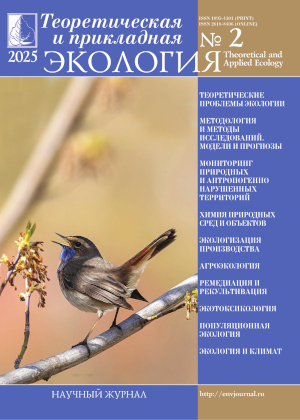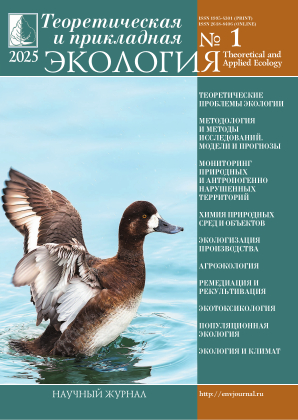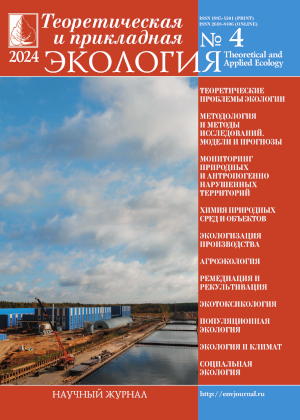 ISSN 1995-4301
ISSN 1995-4301(Print)
ISSN 2618-8406
(Online)
Online version of the journal
|
Geographical and ecological land zoning of onshore oil pipeline location by level of hazard to environment from emergency oil spills in Arctic region |
||||
| A.S. Lokhov, M.G. Gubaidullin, V.B. Korobov, A.G. Tutygin | ||||
| Section: Monitoring of natural and anthropogenically disturbed areas |
||||
| The level of environmental impact from emergency oil spills in the Arctic region is wide variety even for small areas due to considerable heterogeneity of factors affecting the fate of spilled oil. Authors suggest a point rating classification model for assessment the hazard level of oil spills by means of the sum of products of the factor indicators and their weight coefficients. This paper investigates next factors: oil spreading assessment; number of water bodies that can be polluted; surface slope. Calculations performed for “Yuzhnoye Khylchuyu – Varandey” pipeline in the Nenets Autonomous Okrug, Russian Federation. Oil spreading assessment is calculated with hydrodynamic model considering type of soil (in this case – various types of peat), soil permeability, soil humidity, oil viscosity, evaporation of oil and others. Number of water bodies is calculated by means of Earth satellite images, surface slope – by means of topographic map. The number of water bodies on this pipeline was 59, including 39 lakes and 20 rivers. Average surface slope for pipeline was low (1%), this is not so significant for hazard level assessment. Authors determined that level of potential risk to the environment is significantly different depending on factor influence. Paper suggests five-step verbal-numeric rating scale for assessment the hazard level and pipeline zoning was carried out on this basis. | ||||
| Keywords: oil pipeline, onshore oil spills, zoning, Arctic region |
||||
  |
||||
| Article published in number 4 for 2020 DOI: 10.25750/1995-4301-2020-4-043-048 |
||||
|
||||
Cultivation of Spirulina platensis (Nordst.) Geitler on waste water of poultry farms |
||||
| S.Yu. Gorbunova, I.N. Gudvilovich | ||||
| Section: Ecologization of industry |
||||
| The investigation of cyanobacteria Spirulina (Arthrospira) platensis growth in the chicken manure extract (MCE) was carried out. The content of nitrogen and phosphorus in 1 liter of nutrient medium prepared on the basis of chicken manure extract is calculated. In this case, the protein and photosynthetic pigments contents in the cells of the S. platensis is significantly reduced by the 6th days and leads to the culture death. Increasing the volume fraction of the MCE in the nutrient medium has a significant impact on the pigments contents and total protein in the cyanobacteria biomass. Optimum concentrations of extract (20–30%), which provide a high rate of spirulina growth and the accumulation of biologically active substances in the obtained biomass, were determined. It was shown that 20–30% of MCE concentration allows to increase culture yield by 10–20% compared to control sample and to obtain the S. рlatensis biomass containing significant amounts of biologically active substances. It was found that the content of protein, chlorophyll a and C-phycocyanin in the S. рlatensis cells increased by 2.5–6 times at the linear stage of culture growth at the increase of the volume fraction of MCE in the nutrient medium by 5 to 30%. S. рlatensis biomass, produced from such cultivation process, meets the criteria of high-quality biomass contents of protein, chlorophyll a, carotenoids and C-phycocyanin (51, 1.1, 0.4 and 5.5% correspondingly). The approach proposed in the paper allows to reduce material costs for the traditional mineral media preparation for microalgae cultivation. | ||||
| Keywords: Spirulina (Arthrospira) platensis, microalgae, chicken manure, biologically active substances |
||||
   |
||||
| Article published in number 4 for 2020 DOI: 10.25750/1995-4301-2020-4-068-074 |
||||
|
||||
Algorithm for implementing the program of radioecological monitoring of the environment in the vicinity of nuclear and radiation-hazardous facilities |
||||
| E.I. Karpenko, N.I. Sanzharova, A.V. Panov | ||||
| Section: Methodology and research methods. Models and forecasts |
||||
| The main tasks and main stages for implementing the radioecological monitoring system in the vicinity of nuclear fuel cycle facilities are presented. The principles for performing the radioecological monitoring are determined. To improve the efficiency and quality of work in the implementation of projects on radioecological research of the territory, there is a need to develop algorithms for implementing programs of radiation-ecological monitoring and its application in the environmental monitoring system, including the assessment and forecast of changes in indicators of this state. The authors have developed the algorithm of investigations in the framework of environmental radioecological monitoring in the region where nuclear and radiation hazardous facilities are located. A set of independent algorithms has been elaborated for each stage of work, describing the order of actions during conducting radiation and environmental monitoring. The paper presents the conceptual outline for realizing the radioecological monitoring program. The elements of the effective work within the framework of contaminants control in the components of ecosystems and radiation safety assurance of humans and biota are identified. The authors have developed an approach, whereby the researcher has the opportunity to properly organize the sequence of actions to create a network of radioecological monitoring, performing field and cameral work. | ||||
| Keywords: radioecological monitoring, nuclear and radiation-hazardous facilities, radionuclides, environment, algorithm |
||||
| Article published in number 4 for 2020 DOI: 10.25750/1995-4301-2020-4-030-034 |
||||
|
||||
Remote monitoring of overgrowth of higher aquatic vegetation in the water area of the eutrophied reservoir |
||||
| Т.I. Kutyavina, V.V. Rutman, Т.Ya. Аshikhmina | ||||
| Section: Research methods. Models and projects |
||||
| The paper presents information on the distribution of thickets of coastal aquatic and higher aquatic plants in the water area of the Omutninsky reservoir, subject to eutrophication processes. During the route survey of the reservoir, 33 dominant species of aquatic and coastal aquatic plants were identified. Large thickets of higher plants were found in shallow areas in the upper reaches and in the central part of the reservoir along the coastline. Interpretation of satellite images from the Landsat-5 and Sentinel-2A satellites was carried out, the normalized vegetation index (NDVI) was calculated. According to the results of the NDVI calculation, the areas of overgrowth of the water area of the Omutninskoye reservoir with emergent vegetation were calculated. A decrease in the areas of overgrowth in the upper reaches of the reservoir was noted in the period from 2011 to 2019, which is most likely associated with the influence of the temperature factor. | ||||
| Keywords: inland waters, eutrophication, higher aquatic plants, NDVI, remote sensing of the Earth |
||||
   |
||||
| Article published in number 3 for 2020 DOI: 10.25750/1995-4301-2020-3-036-040 |
||||
|
||||
Uncertainty and Multifunctionality: Legal Challenges and Opportunities for Green Infrastructure (GI) |
||||
| Y.M. Gordeeva | ||||
| Section: Social ecology |
||||
| Nature and its vital contributions to people, which together embody biodiversity and ecosystem functions and services, are deteriorating from the changes in land and sea use, overexploitation of animals, plants and other organisms, pollution and climate change. [1] The anthropogenic changes in ecological systems have been so profound that scientists even warn that we have now entered a new geological period – Anthropocene [2]. As we continue degrading our natural environment in order to gain ecological, economic and social benefits, the utilization of “nature-based solutions (NBS)” remains an under-utilized option [3]. GI concept and the implementation of GI emerges as a policy response to address and reverse the current rather counterproductive practice. The European Commission defines GI as a “strategically planned network of natural and semi-natural areas with other environmental features, designed and managed to deliver a wide range of ecosystem services […]” [4]. Yet, designing and implementing GI policy has proved challenging: e.g. how to safeguard sound and effective decision-making in managing complex systems with multiple stakeholders at various temporal/spatial scales, under conditions of uncertainty, with multiple conflicting interests? These and other questions in relation to GI design and implementation were discussed in April, 2020 during the “Woodnet” project [5] international interdisciplinary webinar “Uncertainty and Multifunctionality: Legal Challenges and Opportunities for GI” (administered by the Catholic University of Louvain, Louvain – la – Neuve, Belgium). In the advent of a collective handbook and an international conference on the legal issues of GI design and implementation to be held in 2021, the present article deliberates on the pressing challenges, discussed during the webinar. | ||||
| Keywords: Green Infrastructure, uncertainty, multifunctionality, connectivity conservation, precautionary principle, adaptive management, evidence-based approach, environmental law. |
||||
| Link | ||||
| Article published in number 3 for 2020 DOI: 10.25750/1995-4301-2020-3-217-223 |
||||
|
||||
Effects of acidifying manure effluent on its microbiological characteristics |
||||
| L.V. Pilip, V.A. Kozvonin, N.V. Syrchina, E.P. Kolevatykh, T.Ya. Ashikhmina | ||||
| Section: Agroecology |
||||
| Modern industrial animal husbandry is a significant source of chemical and biological pollution of the environment. Animal manure and slurry present a particular environmental danger during their accumulation and storage until their disposal or application into the soil. The process of microbiological destruction of these wastes results in a wide range of pollutants being formed, including greenhouse gases, ammonia, toxic sulfur compounds, and others. One of the easiest ways to reduce microbiological activity is the acidification of manure effluent. As a result of experimental studies, it has been found that the treatment of pig slurry with a solution of waste sulfuric acid until reaching pH 5.3 leads to a decrease in the number of microorganisms in the treated wastes by 2.2 times on the 7th day and by 7.8 times on the 14th day of the experiment as compared to the control (non-acidified) samples. Acidification results in the elimination of Staphylococcus aureus and Proteus sp., as well as a sharp decrease in the number of Peptostreptococcus sp. and Peptoniphilus sp. in test samples. Implementing techniques for manure acidification on industrial pig farms will improve the sanitary, epidemiological and environmental situation in animal premises. | ||||
| Keywords: pig manure, microbiology, livestock ecology, manure processing, sulfuric acid |
||||
| Article published in number 3 for 2020 DOI: 10.25750/1995-4301-2020-3-161-167 |
||||
|
||||
Approaches for establishing threshold concentrations of priority pollutants in urban ecosystem components |
||||
| Y.A. Tunakova, S.V. Novikova, D.V. Ivanov, A.R. Shagidullin, V.S. Valiev, A.J. Morais | ||||
| Section: Research methods. Models and projects |
||||
| This study was conducted on the territory of the city of Kazan with the dominant aerogenic flow of metals from a significant number of stationary and mobile sources of pollution, causing specific and non-specific responses in the population. Use of modern mathematical methods, ways of assessment of a response of biological objects to anthropogenic influence, chemical analysis researches of content of metals allowed to allocate sources and to determine threshold concentration of metals in urboekosistema components Wednesdays, by the upper bound of acceptable concentration in biosubstrates of teenage children. As a result, we have proposed and tested a methodology for calculating threshold concentrations of essential and toxic metals in snow cover and soils of Kazan, which do not lead to an increase in their regional reference values in the blood and hair of adolescent children. | ||||
| Keywords: metals, snow cover, soil cover, organism biosubstrates, threshold concentrations, regional reference values, neural network modeling |
||||
| Article published in number 3 for 2020 DOI: 10.25750/1995-4301-2020-3-023-028 |
||||
|
||||
Agroecological justification for the use of complex micronutrient-enriched fertilizers in the cultivation of spring soft wheat |
||||
| V.I. Lazarev, J.N. Minchenko, A.Ya. Bashkatov | ||||
| Section: Agroecology |
||||
| According to the studies conducted in 2017-2019, the use of complex micronutrient-enriched fertilizers such as Aquadon - Micro, MicroFeed Complex and Novofert on spring soft wheat crops on chernozem soils of the Kursk region has been proved to be highly effective and en-vironmentally desirable. Seed treatment with complex micronutrient-enriched fertilizers in combi-nation with two-time spraying of crops during the “Tillering” phase and the “Beginning of Erect Growth” phase has increased the yield of spring wheat by 0.57 - 0.75 ton / ha, or 14.7 - 19.4% , and the content of crude gluten in the grain by 1.8 - 2.0% compared with the control. The highest in-crease of economical indexes in cultivation of spring wheat has been achieved through the effective use of complex fertilizer Aquadon–Micro. Seed treatment (2.0 l / ton) and two–time spraying of crops during the “Tillering” phase (2.0 l / ha) and the “Beginning of Erect Growth” phase(2.0 l / ha) has increased the cost of gross output by 7500 rub / ha, the net income by 6,170.0 rub / ha and the profitability by 22.2%. It has also helped to reduce the cost price of 1 ton of grain by 626.86 rub. The economic efficiency of complex fertilizers Novofert and MicroFeed Complex applied in the same way has been proved to be slightly lower than the effectiveness of the Aquadon–Micro fertilizer: the cost of gross output has enhanced by 5700-5800 rub / ha, the net income by 4942– 4770 rub/ ha, the profitability by 18.9–17.9%. The cost price reduction of 1 ton of grain was approximately 541.62–513.93 rubles. | ||||
| Keywords: micronutrient-enriched fertilizers, MicroFeed Complex, Aquadon–Micro, Novofert, spring soft wheat (Triticum aestivum L.), crop yield, crop capacity, gluten content, economic efficiency. |
||||
| Article published in number 3 for 2020 DOI: 10.25750/1995-4301-2020-3-154-160 |
||||
|
||||
Optimization of field crop rotations as a factor of soil fertility preservation and greening of agriculture |
||||
| L.M. Kozlova, E.N. Noskova, F.A. Popov | ||||
| Section: Agroecology |
||||
| One of the main conditions of ecological farming is the introduction of biologized field crop rotations. In a long-term stationary experiment (1982-2017) on the study of various types of field crop rotations in the conditions of the Kirov region, the biological activity of the soil (by the method of linen decomposition), soil toxicity (by the seedlings method), productivity of crop rotations were studied. It has been found that on sod-podzolic middle loamy soil the activity of cellulose-decomposing microorganisms depends on the weather conditions of the growing season, the type of crop rotation, the precursor, the presence of organic matter, the agro-physical properties of the soil. In specialized grain crop rotations, the activity of cellulose-decomposing microorganisms was significantly lower than in crop rotations with 50% saturation with leguminous crops, green-manure fallows, and application of organic fertilizers. Fiber degradation under legumes and tilled crops was evaluated on the D.G. Zvyagintsev scale as from "strong" to "very strong." Soil toxicity increased in grain crop rotations, exceeding 20%. Soil was not toxic (0-6%) in biologized crop rotations when applying organic fertilizers. The lowest percentage of non-grown seeds is observed in the soil of pure and green manure fallows. Crop rotation productivity depended on fertilizer systems and crop composition and aver-aged 3.96-5.69 thousand fodder units. | ||||
| Keywords: crop rotation, rotation cropping system, biological activity, soil toxicity, organic fertilizers, agricultural crops |
||||
| Article published in number 3 for 2020 DOI: 10.25750/1995-4301-2020-3-147-153 |
||||
|
||||
An influence of urbanization on the processes of biological invasions in Arctic (on example of Yamal Autonomous Region) |
||||
| E.M. Koptseva, I.Yu. Popov, D.Yu. Vlasov, E.V. Pershina, E.E. Andronov, E.V. Abakumov | ||||
| Section: Social ecology |
||||
| Urbanized ecosystems of the Arctic environment are considered as the most important example of invasive species redistribution into inhabitats which are not typical for them. In this context, urbanized ecosystems has been investigated in terms of biological invasions and local natural communities transformation into antropogenic ones. It is shown, that transformation of the flora and micro fungi is caused mainly by transformation of hydro thermic regime under the changing of surface of soil cover, which is considered as frequent consequence of the urbanization (construction, mining). Urbanogenic floras are considered as relatively stable and competitive. Indexes of α- and β- biodiversity of microorganisms are very different in soils of technogenic and mature landscapes, which is caused by the presence of the invasive species. The diversity of microorganisms show tend to increase due to antropogenic and ornitogenic translocation, newly formed communities become comparatively stable and results in sanitary-hygienic risks, related to the pathogenesis. An intensification of the tourism, transport activity and increasing of urbanization results in intensive transformation of the local faunas. Urbanized territories increment and expansion results in extending of the area to margin terrestrial borders of Eurasia, this also has an effect in formation of the food chains and holistic changes in ecosystems. | ||||
| Keywords: Arctic, invasions, flora, microorganisms, fauna |
||||
| Article published in number 3 for 2020 DOI: 10.25750/1995-4301-2020-3-210-216 |
||||
|
Pages: previous 1 2 3 4 5 6 7 8 9 10 11 12 13 14 15 16 17 18 19 20 21 22 23 24 25 26 27 28 29 30 31 32 33 34 35 36 37 38
|
36, Moskovskya street, Kirov, 610000, Editorial Board "Theoretical and Applied Ecology." Phone/fax: (8332) 37-02-77 e-mail: envjournal@vyatsu.ru The journal was founded in 2007 |
||||||




 Select viewing options
Select viewing options